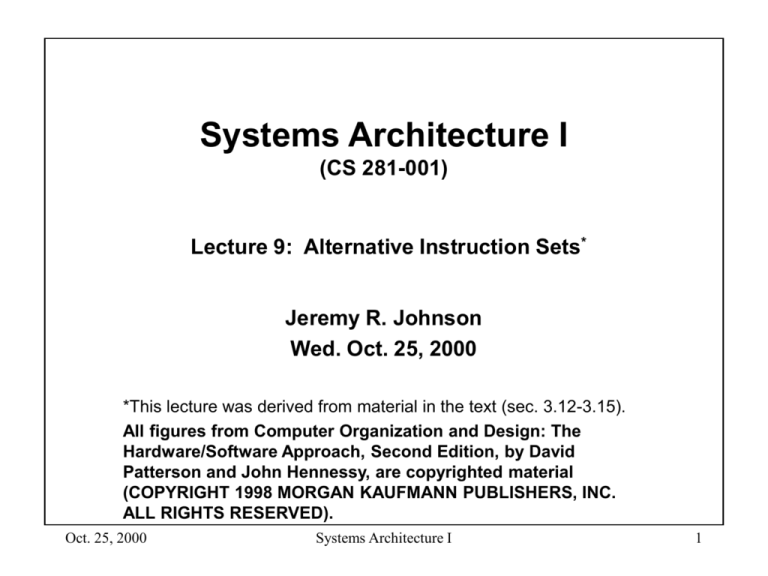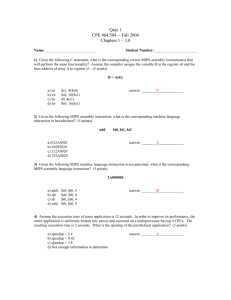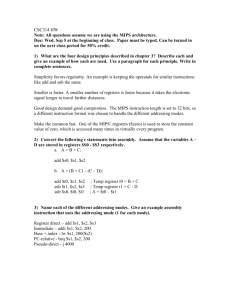
Systems Architecture I
(CS 281-001)
Lecture 9: Alternative Instruction Sets*
Jeremy R. Johnson
Wed. Oct. 25, 2000
*This lecture was derived from material in the text (sec. 3.12-3.15).
All figures from Computer Organization and Design: The
Hardware/Software Approach, Second Edition, by David
Patterson and John Hennessy, are copyrighted material
(COPYRIGHT 1998 MORGAN KAUFMANN PUBLISHERS, INC.
ALL RIGHTS RESERVED).
Oct. 25, 2000
Systems Architecture I
1
Introduction
• Objective: To compare MIPS to several alternative instruction
set architectures and to better understand the design
decisions made in MIPS
• MIPS is an example of a RISC (Reduced Instruction Set
Computer) architecture as compared to a CISC (Complex
Instruction Set Computer) architecture
• MIPS trades complexity of instructions and hence greater
number of instructions, for a simpler implementation and
smaller clock cycle or reduced number of clocks per
instruction
• Topics
–
–
–
–
RISC vs. CISC
PowerPC
Intel 80x86
Historical survey
Oct. 25, 2000
Systems Architecture I
2
Characteristics of MIPS
• Load/Store architecture
• General purpose register machine (32 registers)
• ALU operations have 3 register operands (2 source + 1
dest)
• 16 bit constants for immediate mode
• Simple instruction set
– simple branch operations (beq, bne)
– Use register to set condition (e.g. slt)
– operations such as move built, li, blt from existing operations
• Uniform encoding
–
–
–
–
All instructions are 32-bits long
Opcode is always in the high-order 6 bits
3 types of instruction formats
register fields in the same place for all formats
Oct. 25, 2000
Systems Architecture I
3
Design Principles
• Simplicity favors regularity
– uniform instruction length
– all ALU operations have 3 register operands
– register addresses in the same location for all instruction formats
• Smaller is faster
– register architecture
– small number of registers
• Good design demands good compromises
– fixed length instructions and only 16 bit constants
– several instruction formats but consistent length
• Make common cases fast
– immediate addressing
– 16 bit constants
– only beq and bne
Oct. 25, 2000
Systems Architecture I
4
MIPS Addressing Modes
• Immediate Addressing
– 16 bit constant from low order bits of instruction
– addi $t0, $s0, 4
• Register Addressing
– add $t0, $s0, $s1
• Base Addressing (displacement addressing)
– 16-bit constant from low order bits of instruction plus base register
– lw $t0, 16($sp)
• PC-Relative Addressing
– (PC+4) + 16-bit address (word) from instruction
– bne $s0, $s1, Target
• Pseudodirect Addressing
– high order 4 bits of PC+4 concatenated with 26 bit word address - low
order 26 bits from instruction shifted 2 bits to the right
– j Address
Oct. 25, 2000
Systems Architecture I
5
PowerPC
• Similar to MIPS (RISC)
• Two additional addressing modes
– indexed addressing - base register + index register
• PowerPC: lw $t1, $a0+$s3
• MIPS:
add $t0, $a0,$s3
lw $t1, 0($t0)
– Update addressing - displacement addressing + increment
• PowerPC: lwu $t0, 4($s3)
• MIPS:
lw $t0, 4($s3)
addi $s3, $s3, 4
• Additional instructions
– separate counter register used for loops
– PowerPC: bc Loop, ctr!=0
– MIPS:
Loop:
addi $t0, $t0, -1
bne $t0, $zero, Loop
Oct. 25, 2000
Systems Architecture I
6
Characteristics of 80x86
•
•
•
•
Evolved from 8086 (backward compatible)
Register-Memory architecture
8 General purpose registers (evolved)
7 data addressing modes
– 8 or 32 bit displacement
• Complex instruction set
–
–
–
–
Many variants of an instruction
special instructions (move, push, pop, string, decimal)
Use condition codes
Instructions can operate on 8, 16, or 32 bits (mode) changed with
prefix
• Variable length encoding
– 1-17 bytes, postbyte used to indicate addressing mode when not in
opcode
Oct. 25, 2000
Systems Architecture I
7
Intel 80x86 History and Backward
Compatibility
• 1978
– Intel 8086 (16-bit architecture with dedicated registers)
• 1980
– Intel 8087 floating point coprocessor (with stack)
• 1982
– 80286 (24-bit address space using elaborate memory mapping and
protection model)
• 1985
– 80386 (extends 80286 to 32-bit architecture, new instructions, general
purpose register usage)
• 1989-95
– 80486, pentium pro (a few extra instructions, but mainly performance
enhancements)
• 1997-present
– MMX enhancements, Pentium II, Pentium III, SSE, IA-64
Oct. 25, 2000
Systems Architecture I
8
80x86 Registers
Name
0
Use
EAX
GPR 0
ECX
GPR 1
EDX
GPR 2
EBX
GPR 3
ESP
GPR 4
EBP
GPR 5
ESI
GPR 6
EDI
GPR 7
EIP
EFLAGS
Oct. 25, 2000
31
CS
Code segment pointer
SS
Stack segment pointer (top of stack)
DS
Data segment pointer 0
ES
Data segment pointer 1
FS
Data segment pointer 2
GS
Data segment pointer 3
Instruction pointer (PC)
Condition codes
Systems Architecture I
9
Addressing Modes
• Register indirect
– address in register
– can’t use ESP or EBP
• Based mode with 8 or 32-bit displacement
– address is contents of base register plus displacement
– can’t use ESP or EBP
• Base plus scaled index (not in MIPS)
– Base + (2scale index)
– index not ESP
• Base plus scaled index 8 or 32-bit plus displacement (not in
MIPS)
– Base + (2scale index) + displacement
– index not ESP
Oct. 25, 2000
Systems Architecture I
10
Example Instructions
• JE name
– if equal(condition code) EIP = name, EIP - 128 < name < EIP + 128
• JMP name
– EIP = name
• CALL name
– SP = SP - 4; M[SP] = EIP + 5; EIP = name
• MOVW EBX,[EDI+45]
– EBX = M[EDI+45]
• PUSH ESI
– SP = SP - 4; M[SP] = ESI
• POP EDI
– EDI = M[SP]; SP = SP + 4
Oct. 25, 2000
Systems Architecture I
11
Example Instructions
• ADD EAX,#6765
– EAX = EAX + 6765
• TEST EDX,#42
– set condition code(flags) with EDX and 42 (logical and)
• MOVSL
– M[EDI] = M[ESI]; EDI = EDI + 4; ESI = ESI + 4
Oct. 25, 2000
Systems Architecture I
12
80x86 Instruction Encoding
a. JE EIP + displacement
4
4
8
JE
Condition
Displacement
b. CALL
8
32
CALL
Offset
c. MOV EBX, [EDI + 45]
6
1 1
MOV
d w
8
r-m
postbyte
8
Displacement
d. PUSH ESI
5
3
PUSH
Reg
e. ADD EAX, #6765
4
3
1
32
ADD
Reg
w
Immediate
f. TEST EDX, #42
Oct. 25, 2000
7
1
8
32
TEST
w
Postbyte
Immediate
Systems Architecture I
13
Architecture Evolution
• Accumulator
– EDSAC
• Extended Accumulator (special purpose register)
– Intel 8086
• General Purpose Register
– register-register (CDC 6600, MIPS, SPARC, PowerPC)
– register-memory (Intel 80386, IBM 360)
– memory-memory (VAX)
• Alternative
– stack
– high-level language
Oct. 25, 2000
Systems Architecture I
14








